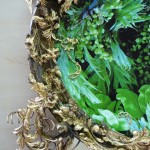Landscapes Re-Framed: Sculptures By Celene Hawkins
By Emil Robinson
The traditional role of the frame in the presentation of art is not as simple as it once was. Many contemporary artists have found interesting ways to question it. Yet the frame continues to hold its traditional role as a way to assign importance to the work of art, and to focus the audience’s attention. Landscapes Re-Framed: Sculptures By Celene Hawkins is on view at the Taft museum through October 20th. Artist Celene Hawkins focused much of her energy into the creation of the frames for this show. Her work asks the audience to view frames in the traditional way, but with subtle ambiguity. Hawkins refers to her framed digital photographs hanging neatly on the wall as “sculptures.”
When visiting a traditional art museum to view paintings, visitors look at the paintings themselves and may not remember the frames that held them. The frames in Hawkins’ show are inspired by historic frames in the Taft’s collection, the architectural details of the building itself, and a local collection of antique frame moldings Hawkins mined for inspiration. The labor involved in this show was extensive, with long hours spent in the fabrication of the frames. The frames stand out for their attention to detail and diversity of finish and form.
Since Hawkins asks us to focus on the frames in her pieces we must evaluate them as art. For all of their careful construction and detail, I hesitate to assign this title to them because it is clear that their effect does not go beyond that of ornament. Hawkins has not done enough conceptually or formally to make the frames supersede their normal role. She comes the closest in the pieces Flutter and Foliate, where the frames have been radically adjusted. The asymmetry of plant forms in these frames begins to be interesting, but I wish it were taken a lot farther. The frames are rich in decoration, texture, and tangible form, but fail to transcend their framing role.
Most of the works in the show feature a digital photograph within the frame. In works such as Thicket it is clear that Hawkins is interested in the imagery of the photo extending into the imagery of the frame. Both the frames and photos feature plant forms. The subject of the show is landscape, and the digital prints feature underbrush. This focus on foliage up close does a good job of immersing the viewer in each piece. The photographs have been digitally manipulated to create color and light effects that feel mechanical and vaguely subversive. However, the impact of the photographs is muffled and blandly pretty. The photographs are especially weak when paired with their ornate historical frames.
Only in the work Foliate do the photograph and frame come together to form something enigmatic. The image in Foliate is one of the most un-manipulated in the show; the plants are green and look mighty healthy. In fact the rich, reproductive ripening is a little alarming. The image reminds us of the power of the natural world from the smallest seed to the force of a hurricane. It also reminds us of the ability of plant growth to take over: our bodies will soon crumble and be fed on by other living things. The frame on Foliate is especially wild looking and the growth from within the frame trespasses the boundary of its picture plane, and enters our own 3-d space.
It is in three-dimensional space that Hawkins shines. The set of purely sculptural pieces in the show are the strongest works. Of special interest are the two related pieces in bronze and gilded plaster Seed and Husk. The two pieces depict the before and after of seed dispersal. These sculptures beckon with intricate detail and a fullness of meaning. Like the piece Foliate that hangs next to it, Seed conjures up a whole range of feelings. The piece is at once organic and alien, precious and utilitarian. The seed hull is connected to the wall with a small plant-like twist of historic ornament, and the effect is pitch perfect as the viewer is caught between man-made and nature-made. It is this place between natural and manufactured that Hawkins seems to reside in naturally. This is certainly prescient territory, but for most of the works in Landscapes Reframed, Hawkins fails to implicate us in a meaningful way.






